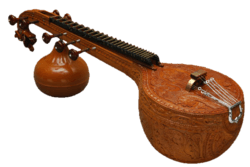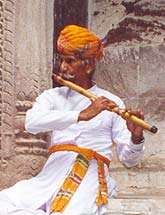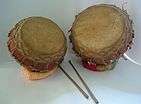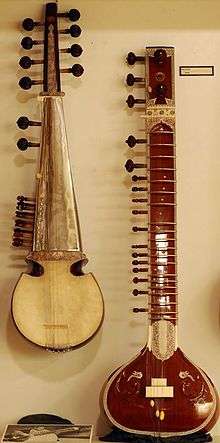Vadya
Vadya (IAST: Vādya, वाद्य), also called Vadyaka or Atodya, is one of the three components of sangita (musical performance arts), and refers to "instrumental music" in the Indian traditions.[1][5][6] The other two components of sangita are gita (vocal music, song) and nrtya (dance, movement).[1][7][4] In the general sense, Vadya means an instrument and the characteristic music they produce, sound or play out.[8][9]
| Indian classical music |
|---|
 |
| Concepts |
The term Vadya in the sense of "music, sounded, played, uttered" appears in the Vedic literature such as in the Aitareya Brahmana, and in early post-Vedic era Sanskrit texts such as the Natya Shastra, Panchatantra, Malvikagnimitra and Kathasaritsagara.[5] These texts call the musician or the performer on the musical instrument as Vadyadhara.[5] A stringed instrument is described with proportional lengths in Jaiminiya Brahmana and Aitareya Aranyaka, and these are compared to poetical meters.[10]
The Sanskrit literature such as Natya Shastra describes four types of Vadya:[4][6][11]
- Tata: stringed musical instrument (chordophone)
- Susira: hollow musical instrument (aerophone)
- Ghana: solid musical instrument (idiophone)
- Avanaddha: covered musical instrument (membranophone)
The chapter 14 of the Saṅgītaśiromaṇi describes musical ensembles based on a collective performance of vadya instruments by musicians, and it calls such a band orchestra as a Kutapa.[12] The term Vadya also appears in the Buddhist Sanskrit text Sukhavativyuha, influential in the Chinese and Japanese traditions, which Luis Gomez translates as "instrumental music".[13] The 17th-century text Sangeeta Darpana defines sangita (musical arts) as "Gītam Vādyam Tathā Nrityam Trayan Sangeeta Muchyate", which states Dona means, sangita comprises gīta (vocal music), vādya (instrumental music) and nritya (dance).[14]
In Hindu-Javanese music tradition, Vadya is called Vaditra.[7] According to Roger Blench, most scholars consider the African term Valiha for tube zither to be rooted in the Sanskrit term Vadya, reflecting a period of cultural exchange over the Indian Ocean.[15]
See also
- Indian classical music
- List of Indian musical instruments
- Natya shastra
- Tala
References
- Lewis Rowell (2015). Music and Musical Thought in Early India. University of Chicago Press. p. 13. ISBN 978-0-226-73034-9.
- Bigamudre Chaitanya Deva (1995). Indian Music. Taylor & Francis. pp. 95–96. ISBN 978-81-224-0730-3.
- Rachel Van M. Baumer; James R. Brandon (1993). Sanskrit Drama in Performance. Motilal Banarsidass. pp. 117–118. ISBN 978-81-208-0772-3.
- Alison Arnold; Bruno Nettl (2000). The Garland Encyclopedia of World Music: South Asia : the Indian subcontinent. Taylor & Francis. pp. 19–20. ISBN 978-0-8240-4946-1.
- Monier Monier-Williams, Sanskrit-English Dictionary with Etymology, Oxford University Press, page 940
- Dilip Ranjan Barthakur (2003). The Music and Musical Instruments of North Eastern India. Mittal Publications. pp. 3–4. ISBN 978-81-7099-881-5.
- Jaap Kunst (2013). Hindu-Javanese Musical Instruments. Springer Science. pp. 88 with footnote 26. ISBN 978-94-011-9185-2.
- Lewis Rowell (2015). Music and Musical Thought in Early India. University of Chicago Press. pp. 113–114. ISBN 978-0-226-73034-9.
- Mandakranta Bose (2012). Movement and Mimesis: The Idea of Dance in the Sanskritic Tradition. Springer Science. p. 57. ISBN 978-94-011-3594-8.
- Emmie Te Nijenhuis (1992). Saṅgītaśiromaṇi: A Medieval Handbook of Indian Music. BRILL Academic. pp. 12–14. ISBN 90-04-09498-9.
- Bonnie C. Wade (1987). Music in India: The Classical Traditions. Riverdale Company. p. 88. ISBN 978-0-913215-25-8.
- Emmie Te Nijenhuis (1992). Saṅgītaśiromaṇi: A Medieval Handbook of Indian Music. BRILL Academic. pp. 524–525. ISBN 90-04-09498-9.
- Luis Gómez (1996), The Land of Bliss: Sanskrit and Chinese Versions of the Sukhāvatīvyūha Sutras, University of Hawaii Press, ISBN 978-0-8248-1760-2, page 72 (verse 28.23)
- Dona, Lasanthi Manaranjanie Kalinga (2012). "On the Therapeutic Aspects of Indian Classical Music". Musik-, Tanz und Kunsttherapie. Hogrefe Publishing. 23 (1): 8–14. doi:10.1026/0933-6885/a000069.
- Roger Blench (2014), Using Diverse Sources of Evidence for Reconstructing the Past History of Musical Exchanges in the Indian Ocean, African Archaeological Review, Volume 31, Issue 4 (December), pp 675–703



.png)
